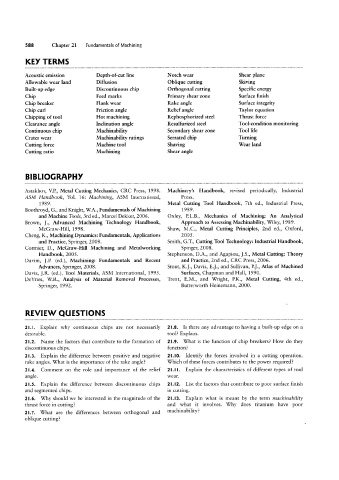Page 607 - 04. Subyek Engineering Materials - Manufacturing, Engineering and Technology SI 6th Edition - Serope Kalpakjian, Stephen Schmid (2009)
P. 607
588 Chapter 21 Fundamentals of Machining
KEY TERMS
Acoustic emission Depth-of-cut line Notch wear Shear plane
Allowable wear land Diffusion Oblique cutting Skiving
Built-up edge Discontinuous chip Orthogonal cutting Specific energy
Chip Feed marks Primary shear zone Surface finish
Chip breaker Flank wear Rake angle Surface integrity
Chip curl Friction angle Relief angle Taylor equation
Chipping of tool Hot machining Rephosphorized steel Thrust force
Clearance angle Inclination angle Resulfurized steel Tool-condition monitoring
Continuous chip Machinability Secondary shear zone Tool life
Crater wear Machinability ratings Serrated chip Turning
Cutting force Machine tool Shaving Wear land
Cutting ratio Machining Shear angle
BIBLIOGRAPHY
Astakhov, VP, Metal Cutting Mechanics, CRC Press, 1998. Machinery’s Handbook, revised periodically, Industrial
ASM Handbook, Vol. 16: Machining, ASM International, Press.
1989. Metal Cutting Tool Handbook, 7th ed., Industrial Press,
Boothroyd, G., and Knight, WA., Fundamentals of Machining 1989.
and Machine Tools, 3rd ed., Marcel Dekker, 2006. Oxley, RL.B., Mechanics of Machining: An Analytical
Brown, J., Advanced Machining Technology Handbook, Approach to Assessing Machinability, Wiley, 1989.
McGraw-Hill, 1998. Shaw, M.C., Metal Cutting Principles, 2nd ed., Oxford,
Cheng, K., Machining Dynamics: Fundamentals, Applications 2005.
and Practice, Springer, 2008. Smith, G.T., Cutting Tool Technology: Industrial Handbook,
Cormier, D., McGraw-Hill Machining and Metalworking Spinger, 2008.
Handbook, 2005. Stephenson, D.A., and Agapiou, ].S., Metal Cutting: Theory
Davim, ].P. (ed.), Machining: Fundamentals and Recent and Practice, 2nd ed., CRC Press, 2006.
Advances, Springer, 2008. Stout, K.]., Davis, E.]., and Sullivan, P.]., Atlas of Machined
Davis, ].R. (ed.), Tool Materials, ASM International, 1995. Surfaces, Chapman and Hall, 1990.
DeVries, W.R., Analysis of Material Removal Processes, Trent, E.M., and Wright, P.K., Metal Cutting, 4th ed.,
Springer, 1992. Butterworth Heinemann, 2000.
REVIEW QUESTIONS
2l.l. Explain why continuous chips are not necessarily 2l.8. Is there any advantage to having a built~up edge on a
desirable. tool? Explain.
2|.2. Name the factors that contribute to the formation of 2|.9. What is the function of chip breakers? How do they
discontinuous chips. function?
21.3. Explain the difference between positive and negative 2I.I0. Identify the forces involved in a cutting operation.
rake angles. What is the importance of the rake angle? Which of these forces contributes to the power required?
2|.4. Comment on the role and importance of the relief 2I.| I. Explain the characteristics of different types of tool
angle. wear.
21.5. Explain the difference between discontinuous chips 2 |.l2. List the factors that contribute to poor surface finish
and segmented chips. in cutting.
2|.6. Why should we be interested in the magnitude of the 2|.|3. Explain what is meant by the term mac/ainability
thrust force in cutting? and what it involves. Why does titanium have poor
2I.7. What are the differences between orthogonal and machinability?
oblique cutting?

